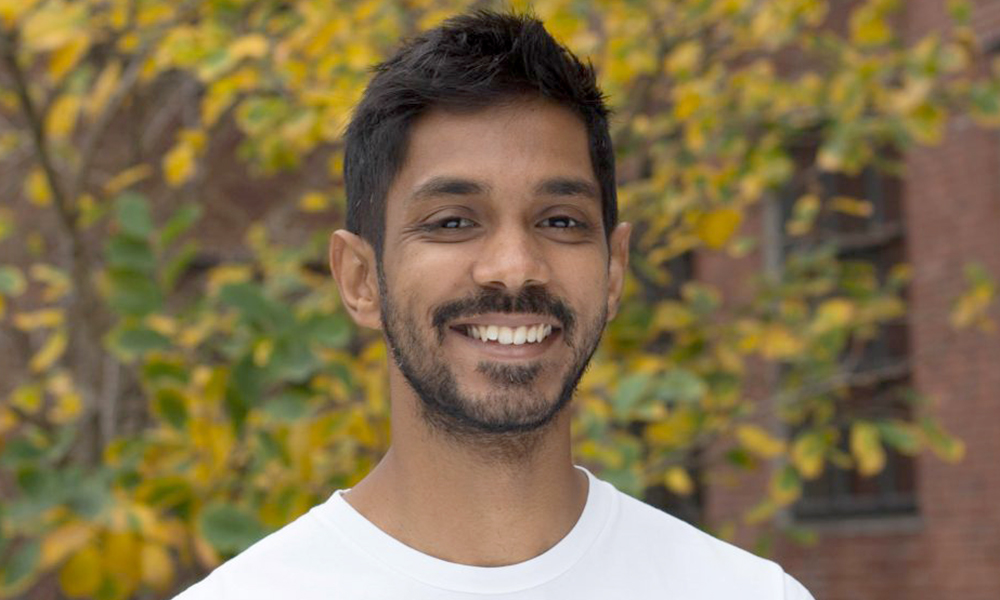Born in Hyderabad, India, Abhinav Grama’s first encounters with science were through books. “I would devour all kinds of books,” he recalls. Medical thrillers by physician-turned-novelist Robin Cook made a big impression on young Grama, but he now finds those books “kind of cheesy.”
Today, as a postdoc in the Cox Lab, Grama has moved from medical mysteries to even bigger questions—the brain and consciousness. “We have many great mysteries in the world,” he says. “The universe was one of them, and I guess, for me, the brain was the other big one.”
Specifically, Grama studies visual perception. When he talks about research, he speaks quickly and animatedly. “People always assume that what you see is what your eyes see,” he says. However, the images that humans “see” are actually composites that incorporate information from both eyes. Many neural circuits help translate the images that the eye detects into perception. When someone looks through a device called a stereoscope, it shows two completely different images to each eye, but the two stereoscope images appear to alternate. “Your eyes are constantly seeing [both] these stimuli, but you, as a conscious entity, are only aware of one or the other [at a time],” Grama explains.
Scientists call this alternating effect binocular rivalry. Researchers have studied binocular rivalry for over a century and a half, but no has studied it in rats—until Grama.
Rat research allows scientists to look inside the brain and see which neural circuits are active during visual perception. To get the best possible view of the neural circuits, Grama surgically installs transparent windows into the rats’ skulls, which allow him to see directly into the rat’s brain. Each of these surgeries takes 7-8 hours..
Grama, who has been a vegetarian his entire life, has mixed feelings about the surgeries. “It was a very difficult decision for me to start working on rats, but…I do believe that science needs to move forward,” he says. “I sort of made my peace with that. It’s going to be done either way, and if I’m doing it, I will probably try to approach it from a more humane perspective.”
For the project, he invented and built a rodent version of a stereoscope that shows alternating images to the rats. But while humans looking through a stereoscope can tell a researcher what they’re seeing, lab animals can’t. To get around this issue, Grama records the rats’ eye movements and pupil size changes.
When the rats watch two images moving in opposite directions, their eye movements reveal the direction of the motion that the rat is perceiving. The same switch-up happens in humans experiencing binocular rivalry, Grama says. These data strongly suggest that rats experience binocular rivalry, too.
“We now have conclusive evidence that rats actually experience this [binocular rivalry] effect,” says Grama. “The most convincing [experiment] is the one where you present each eye with stimuli moving in opposite directions.”
These experiments also require building new microscopes. Here, Grama’s undergraduate engineering background comes in handy. He studied Biotechnology at the Indian Institute of Technology in Madras, one of the country’s most prestigious engineering schools. “It was a pretty broad education,” he recalls. “We learned electronics. We learned elements of mechanical engineering [and] building things in workshops.”
His first undergraduate summer internship took him to the Penelope Higgs’ lab at the Max Planck Institute for Terrestrial Microbiology. In his next internship in Oliver Schlüter’s lab at the European Neuroscience Institute, Grama began working synapses. He has stayed focused on neurons ever since. His third undergraduate internship Colin Taylor’s lab at the University of Cambridge taught him calcium visualization techniques that would prove useful in his later research.
After undergrad, Grama moved to Harvard to study as a graduate student in the Engert Lab. His Ph.D. research focused on the required building even more microscopes in order to record single neurons in zebrafish embryos.
“Abhinav was a phenomenal addition to my lab,” says MCB professor Florian Engert. “What made him particularly impressive was his unbridled enthusiasm, the genuine curiosity with which he approached any research project and his deep and wide-ranging intellect…Combined with his collegiality, ready helpfulness and his sincere compassion and readiness to assist those in need, he made the lab an altogether better place to work and to spend time.”
In addition to his binocular rivalry work, Grama is part of a broader Cox Lab effort to reverse-engineer computational processes that take place in just one tiny chunk of the brain. The project, called Machine Intelligence from Cortical Networks (MICroNS), has been compared to the Apollo Program in scale.
Grama’s contribution was capturing images of rats’ brains. Other labs are using these images to diagram neural circuits. The long-term goal is to map out the learning rules that the brain uses and code them into computer programs.
This work at the interface between brain sciences and artificial intelligence drew the attention of AI research powerhouses. Professor Cox is currently setting up shop as the newly appointed director of the MIT-IBM Watson AI lab. The position is an extremely prestigious one, but, unfortunately, Cox’s move means that his Harvard neuroscience research is winding down.
Grama isn’t completely certain what his next move will be. At present, he’s applying for fellowship positions. He’d like to continue studying perception and consciousness, but he has to find a home for the rats with windows in their heads first.
When he’s not using microscopes to capture images for science, Grama can often be found photographing the world around him as a hobby. He also enjoys biking through the local wilderness.
In the meantime, he plans to continue using rats’ visual systems as an entry point into understanding perception. “It sort of gets at these harder questions of what exactly is consciousness?” Grama says. “This question has bothered philosophers for thousands of years, and I don’t think there’s going to be a very clear answer just yet.”


